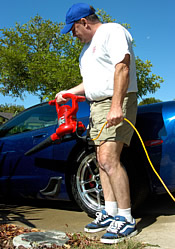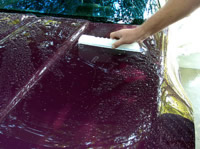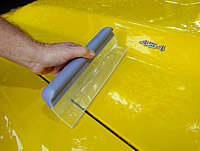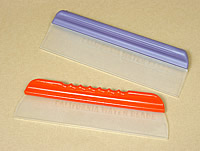Practical Car Care for Corvetters: Washing - Page 2 of 2
© 2007 by Hib Halverson
No use without permission, All Rights Reserved
 Discuss this article
Discuss this article
Now, you need a device for washing. There's lots of talk about wash mitts but, they're not good choice because most mitts are not free-rinsing, ie: getting them to unload grit and grime in the wash bucket is difficult. We feel a sponge is a better choice and we like the "Microfiber Super Sponges" (PN 22103) the California Car Duster people sell because they have enough microfiber in their covering to aid in cleaning but do not have the difficult-to-rinse "shaggy" form-factor of most wash mitts and are a good value. To lift stuck-on bugs and so forth from the nose of the car, Grit Guard sells the "Multi-Task Scrubber" which is ideal for applications where you need something just a little more aggressive than a sponge.
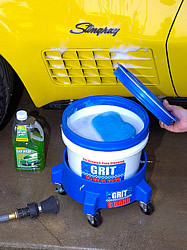 |
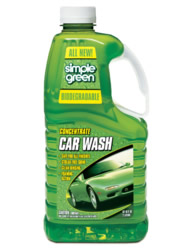 |
Click image for larger view
As far as value goes, this is our choice for Car Wash "soaps". The 64-oz jug goes a long way. It does a good cleaning job and it's biodegradable. Image: Sunshine Makers |
Click image for larger view
We tested this crossbreed of sponge and microfiber from California Car Duster and found the "Microfiber Super Sponge" to work quite well. It's better than a ordinary sponge because of the cleaning action of the microfiber, but it doesn't have the dirt shedding problems some wash mitts have. Image: Author |
Spray the car with your Bon-Aire, slop on the soap and water with your sponge and start scrubbing. Do the car in sections. Soap then rinse each section. Start with the top and all the glass, the hood and rear deck, each side and then finish with the wheels.
The last car wash operation, and the one most critical to your car's finish, is drying. The first thing you shouldn't do is reach for that old chamois or go into the bathroom and get bath towels or, worse yet, go to the closet and get some old beach towels. In researching this story, we spoke to several experts on car care and they all agree that one of the more brutal things you can do to your Vette is dry the car with a bath or beach towel. First, they're not as soft as you think. Second, they don't suck-up as much water as microfiber. Third, and most worrisome, cotton terry-cloth towels can hold dirt--or sand in the case of a beach towel--in the base material, in-spite of washing. Finally, laundering itself, if it's done with powdered soaps, may leave soap particles imbedded in the cotton.
There are two methods we think are the best choices for drying. If you are truly anal-retentive about limiting contact of wiping devices with your car's paint where possible, use the blow-dry method. This requires a powerful electric leaf blower and we like the Toro "Ultra Blower" (PN 51599). Stick on its blower tube, lock the inlet cover in place, plug it in and turn it on high then blow all the remaining water off all the car's surfaces.
Blow-drying pitfalls? 1) if the wash water was even mildly alkali, you'll get water spots. Blow-drying only works with "soft" water and 2) the cost--some may balk at spending 75-100 bucks on a killer leaf blower to dry cars. That said, provided those issues don't present problems; blow-drying is the only way to dry your Vette with zero stress to its finish. Because units like the Toro are double-insulated and the connection to the piece of equipment is above ground, as long as your extension cord is designed for outdoor use, is grounded, not frayed or otherwise faulty; the Toro leaf blower is safe to use when walking on a wet surface, however, do not spray with or immerse the leaf blower in water.
If a blow-dry is not your choice, we recommend using a "California Water Blade" to wipe most of the water off the car then follow with a microfiber towel to dry the nooks and crannies. Russ Romer, Vice President at Water Blade manufacturer, California Car Duster Company, told the CAC,"The inventor of the Water Blade is an industrial engineer who's also an automotive enthusiast and custom car builder. He wanted an effective drying device which would not damage the surface. He developed the unique combination of the efficient 'T-Bar' blade and the soft, slippery nature of the silicone, such that when the device is in contact with a surface, it completely removes water.
"A Water Blade's working surfaces are made of injection-molded, medical-grade, silicone which is far softer than typical cotton towels many use to dry their Corvettes. Chamois and towels pick up water, but can leave a trail. True Chamois are not only difficult to use but, also, may remove waxes.
"A typical car drying takes about a third of the time using a Water Blade to do 90% of the car's exterior surface and a microfiber towel, such as our 'Mr. Thirsty,' to do the rest."
A Water Blade's patented "T-Bar" edge allows it to move water in either direction increasing the tool's efficiently. The Original California Water Blade has a rigid handle which somewhat limits its ability to conform to radiused surfaces. The newest evolution of this device, the "Jelly Blade," has a greater ability to conform to curves due to its flexible handle.
Some theorize that tiny dirt particles which drop out of the air into the rinse water or impurities in the water itself could get caught under the tip of the blade and scratch the paint. In practice, there are three reasons why that's not a problem: 1) as long as the blade remains in contact with the surface, particles are more likely to be washed ahead by the blade's "bow wave", rather than be "rolled-over" like they would with a bath towel or a chamois, 2) silicone generates much less friction so, unlike towels and chamois, it's far less likely to "drag" contaminants along the surface and 3) the amount of dirt, dust and contamination that is trapped in a towel or chamois, even one which has just been washed, dwarfs that of any microscopic particles which could be pulled along by a Water Blade.
As to which one of these products to use? It's mainly a matter of feel. Personally, I prefer the Original Water Blade which came to market in 1996. I have one in the shop which I've used for ten years. I'll betcha I've dried my three Vettes 500 times with that thing. I like the feel of the ergonomically-designed grip, the tool's weight and balance and I prefer its rigidity.
Conversely, for this article, we tested a Jelly Blade and found it easier to use and capable of better results on the tightly radiused or compound-curved body panels more common on C1, 2, 3 and 6 body styles. I'll keep one of each in the shop and use the unit which best suits the car I'm drying. There are two other products in the Water Blade line for light vehicles, the "Dry Blade" and the "T-Blade" but they are entry-level products intended for those more focused on low price rather than ease-of-use. Neither is a good choice for for serious Corvette cleansing.
The microfiber towels best for finishing up after Water Blading are Cal Car Duster's "Mr. Thirsty", which was specifically designed to compliment a Water Blade, or Grit Guard's microfiber "Waffle Weave Drying Towels". Either way, you'll get most of the wet with the Water Blade then need only one microfiber to get the rest.
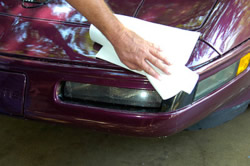 |
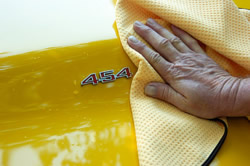 |
Click image for larger view
Once you've Water Bladed the car, there will be small areas where the Blade just won't work. For that you need a microfiber drying towel, like this Cal Car Duster "Mr. Thirsty". Image: Author |
Click image for larger view
Another towel which works well for "detail drying" is this Grit "Guard Waffle Weave Drying Towel." The waffle texture aids in absorption. Image: Author |
Sources:
Bon-Aire Industries
873 East Citation Ct.
Boise ID 83716
800.874.5771
www.bon-aireindustries.com
C-Magic
Suite 100
2205 Stonegate
Denton TX 76205
866.760.2929
www.cmagicwax.com
California Car Duster Company
9525 DeSoto Av.
Chatsworth CA 91311
800.282.8828
www.waterblade.com
Grit Guard, Inc.
3690 County Rd 10
Bellefontaine OH 4 3311
866.592.5925
www.gritguard.com
Sunshine Makers (Simple Green products)
15922 Pacific Coast Hwy.
Hungington Harbor CA 92649
800.228.0709
www.consumer.simplegreen.com

